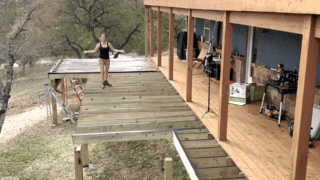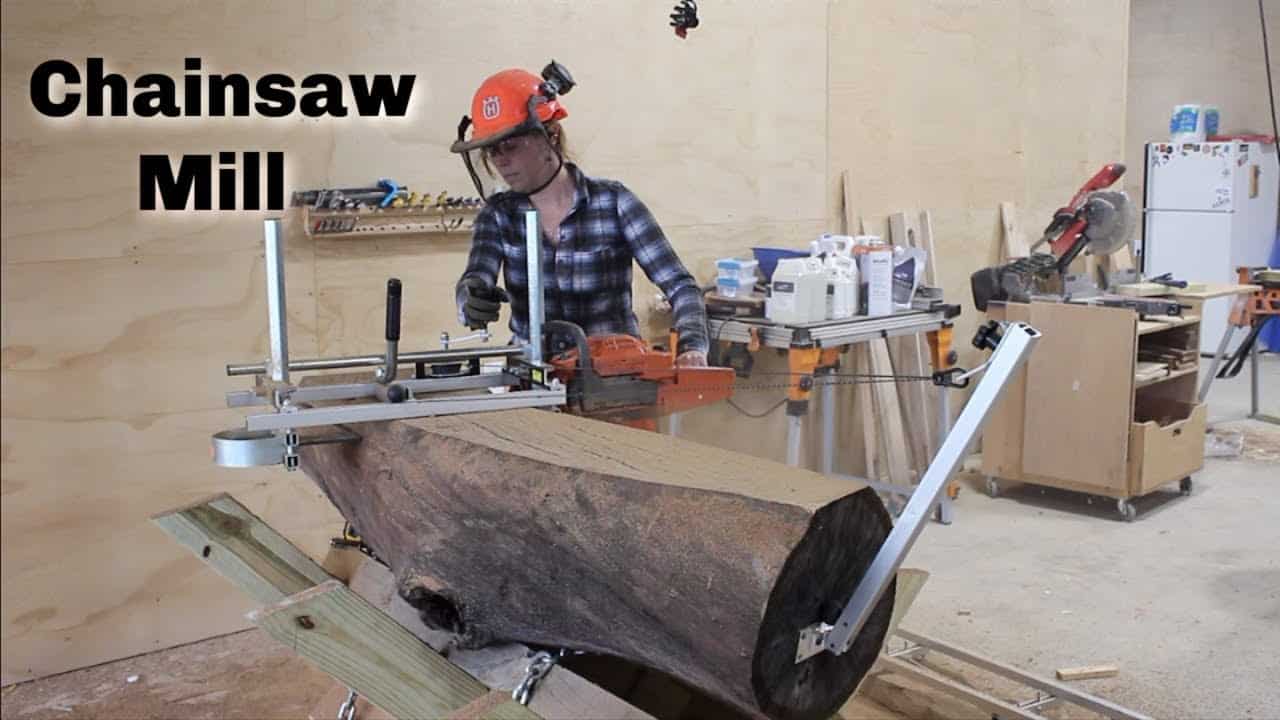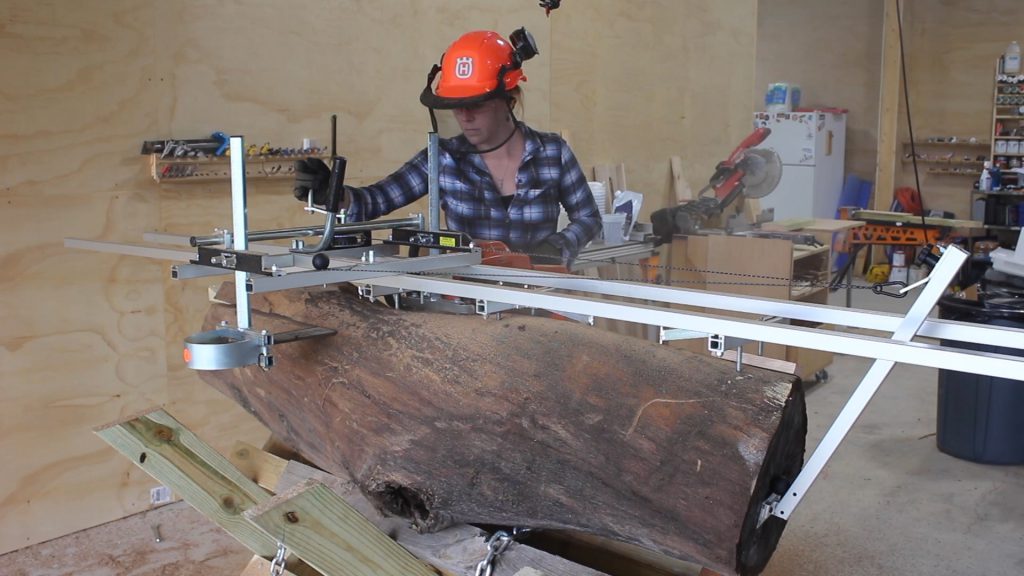
Chainsaw Mill | How to Slab Logs
- Outdoor DIY Projects
- April Wilkerson
- Updated: March 5, 2023
Wondering how to slab logs? Check out this DIY project where I show you how I use my bandsaw mill to slab my own logs!
Last week I modified a trailer to go get some logs, this week I’ll be slabbing them up. As milling is an entire world of it’s own in the woodworking niche, I learned a crazy amount in just a few days and I’m going to try and cram as much of that information into this video as possible, so lets gets right to it.
There are two main methods for milling logs: a bandsaw mill like Matt Cremona’s…
…or a chainsaw mill. I’m going with a chainsaw mill…..for now. Tractor Supply is now a supplier of Husqvarna equipment and I’ve partnered with them to use the Rancher 460 chainsaw with a 24” bar on my mill. Note that the chainsaw you buy has specs on the longest bar it can support. So if you want to cut certain diameter logs, be sure to buy a saw that can support it.
I’m actually going to jump ahead because there are a lot of components to this one so let me show you the final outcome before I get into the details of each one.
The components are: the chainsaw of course. Next is the mill which is a railing system parallel to the chainsaw bar that guides you for a straight cut.
On your very first cut, you need a flat reference for the mill to ride along, which is what these rails here are.
Then something I put on mine but is optional is a winch. This is mounted to the mill then hooks up to this bar you see here.
Now that you see what I end up with, let get back to the beginning of putting it together. I started off with the rails that will go ontop of my logs to give my mill a flat reference for the first cut. You might have seen people use a ladder for this application before, but I went with rails made by the same company who made the mill I’ll be using which is a family owned business called Granberg. They are called EZ Rails and do come in a variety of different lengths but I went the 10’ rails which come in two 5’ sections that can be used separately or together. They have these cross bars with spikes and this is how the rails are attached to the log.
Next I switched out the stock chain on my chainsaw, which is a crosscut chain, to a ripping chain. Just like any other saw blades, the teeth are designed with a certain task in mind and if you are going to go from crosscutting to slabbing, you need to invest in a ripping chain. The teeth are filed to a steeper angle on ripping chains since it’s a much more aggressive cut since you are cutting along so many more growth rings lengthwise.
After getting the chain on and tighten down, I moved on to assembling the mill that goes around the chainsaw. This is the railing system that is parallel to the blade, and it can be raised or lower to determine the thickness of your slab. Since I have a 24” bar I went with the 24” mill from Granberg.
And just a fun fact, Elof Granberg, who started the company, designed the first Alaskan chainsaw mill back in the 60s. So anything milling related, the company has.
You can see that the chainsaw now fits right into the mill then tightens down on the bar to hold onto it.
Like I mentioned earlier, an add on I opted in for is a winch on the mill. This will drastically reduce the amount of work I manually have to do to get the saw through the piece of wood and I’ll show you how this works in a few mins.

First I want to set all that equipment aside and quickly build a log stand so I don’t have to cut these logs on the ground. Since I’ve never done this before I wasn’t sure what set up would be best, so I went with some 2x6s with a steep angle cut in at both ends on my miter saw, then a hole drilled in the center. I flipped them around to be opposite of one another then stuck in a bolt with a few washers and nuts. I used two nuts so that I could keep this joint pivoting which will make the stand foldable.
After repeating to make three the same, I lined them out, used a clamp to hold them in an open position with the feet flat on the floor, then placed another 2×6 to tie them together, and to also create a hard stop. A 2×6 was placed on both sides and now you can see it can fold up and be stored or transported, but then quickly deployed to be used. Depending on your length of logs, should determine how many of these Xs you include on your stand.
Ok! After all that assembly I was finally ready to get a log set on my stand and to start milling. Cody used the tractor to snatch onto a log on the trailer then set it in position. Now the log doesn’t have to be perfectly flat but the next step is easiest if it is somewhat flat, so I first started up my 460 and took off a high spot.
With this being the first cut, I started by placing my EZ Rails in place. Again, these will be the flat reference for my mill to get a straight first cut. I lined up the cross members so that the spikes, or dogs, would all land on the log then I hammered them in.
With it attached I next leveled up the rails. You don’t need them to be level along the length of the log, just across the log, I don’t know if you can see but there are two leveling screws at each one of these cross members to make this happen.
Then the last thing to attach is the winch’s anchor point. If used, this is attached to the end of the log so that it can peak up in between the two rails. And you can see here that once you start the saw and get the mill set on the rails, the winch cable goes from the reel to this anchor point then attaches back to the mill. This allows me to keep my left hand on the throttle of the saw, and my right hand on the winch to advance or back off on the cut.

A few things I want to say:
1) Beware folks because this is highly addictive. I want to slab up everything now to where if you stand still long enough in my shop, I’ll start attaching the rails to you!
2) This operation can be done alone but it’s kinda a lot and is sooo much easier if you have a second hand around. You’ll see Brain there cutting wedges for me and placing them as I get further into the log. This is to keep the slab from pitching your bar and binding.
3) I tried moving the mill along without the winch just to see the difference and I’ll say that the winch makes such a huge difference in how much effort is required. I 100% recommend it if you get into this.
After getting through my first cut (which took 6.5 mins btw), I set the top aside then started on the second cut. Now that the log has a flat reference along the top I no longer need the EZ Rails, I can just set the mill directly onto of my previous cut and start the process over again. The only thing I had to do before making this cut was to adjust the depth of my mill to the slab thickness I wanted. I set it for 2” then got after it.
I am really shocked at how quickly I was able to get through an entire cut, this second cut took me just under 5 mins to make. The main components for making that happen is much like any other cutting tool in the shop…..the right power source and a sharp edge. This Husquvarna had no issues chopping through this oak, mesquite, or even pecan which are all pretty hard woods. This work does use up the bar oil though, so make sure you are keeping an eye on your tank.
Now I won’t lie, I was pretty disappointed at this oak when I got a look inside. I was hoping this thing would be beautiful but the log was apparently pretty old and very dried out so the inside was really cracked and honestly not something I was interested in keeping. Looking back on it though, I think testing and tuning, getting things figured out on a junk log is a pretty good way to go. Like anything else you learn so much on your first go and I still had a blast.
I didn’t have any more long logs but my neighbor offered me a short pecan and mesquite log so I jumped at those to try next. You can see that instead of cutting the tops of my log stand down, I just shored up the bottom with some scraps. This is because I’m not yet sure what the average diameter of log I’ll be getting is, and I didn’t want to cut them too short but note that it is an alternative to filling up the bottom.
Something else I did when the log got smaller was use the log jaws in my Super Jaws. These are a set of jaws with blunted teeth specifically designed for grabbing onto logs. Oh and a helpful tip I got from Instagram is instead of placing the log level lengthwise, place it downhill so that gravity can help you when you are milling through.
As far as keeping things sharp, I sharpened my chain after every third pass which might be excessive but I’ll learn with time where the sweet spot is on sharpening. In the past I’ve always used a file to sharpen the teeth but Grandberg has this 12v electric sharpener that attaches right to the bar. It hooks up to a truck or car battery so I used the battery from the log snatching trailer to run it. Even if you don’t get into milling this sharpener is worth getting.
The last thing I had to slab up with this crotch piece of pecan, after making the first cut I stuck it in my super jaws to make the remaining cuts and just look at how cool this one came out!
The next step is to set the slabs aside to dry and a general rule is it takes one year for every inch of thickness. So a 2” slab should be left to dry for two years. For video sake, lets say it’s been two years and these are now dry and ready to be used to make something.
I’ll first need to flatten the slab. Since it’s much wider than a jointer the most popular method for flattening slabs is called a router sled. You can make a home made jig but my friends over at Woodpeckers Tools heard I was slabbing and asked me to try out their new slab flattener coming out later this year. If you are familiar with Woodpeckers then you’ll know they excel at precision which is exactly what a flattener needs to get the best results. Everything needs to be level and stay level to give you a perfect cut across your entire slab so you don’t have a lot, or any post clean up work to do. The jig has two long rails that I temporarily attached to my workbench, then it also has a sled that sits onto these rails. Inside this sled is where a router base is set so that it can slide up and down the length.
After taking my time to get everything set up, I positioned my slab and set the depth of my router bit to start removing material to flatten the slab. I’m using my Triton 2 1/4” Router since I have my larger 3 1/4” in my table. Then for a bit I’m using a 2” flattening bit and also a bit extender made by Infinity. If you don’t have this extender and you just have the bit in your router, it’s really common for the bit to run out of throw and not get down far enough to hit your slab.
With things set up you can see how it works. The router base moves along the sled then the sled moves along the rails. Allowing you to gradually move over the slab in order to flatten it. That is a wicked cool tool if you ask me.
If you have never flattened a slab before then here are a few things I learned from my experience.
When working with a piece that has a slight twist in it, you first need to shim it up and keep it stable to flatten it. I would find the two corners that were rocking then stick in a few wedges.
Next I set the bit according to the highest spot on the slab so that it starts off with removing the high spots. This means you aren’t removing material everywhere on the slab on the first pass. The objective is keep removing all of the high spots pass by pass until you are finally removing material from the entire slab, meaning it’s all on the same level and is flat.
I set the bit to take off about 1/8” material. Also remember that with a larger diameter bit, you will want to slow the speed of your router down. I have my router set to 2 out of 5. I start on one side of the slab, move the router across then bring it back. Once I bring it back I move the entire sled down the slab to advance the cut. And that’s it, it’s just a matter of repeating until I make it across the entire slab.
Once I get the slab down to where I’m removing material from everywhere evenly, I change the bit depth for a final smoothing pass. And this is to just to cut down on some of the marks left behind from the rough cuts, but honestly if you keep your bit sharp you’ll be amazed at how perfect the surface feels.
I hope you found this informative. I cant believe the mount of information I learned in just a week! And of course, now I cant wait until I have my own inventory of wood that I’ve milled up myself. Stay tuned for my next video which will be turning live edge slabs into furniture.